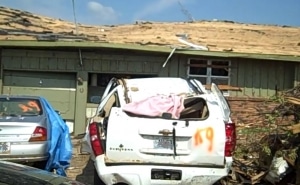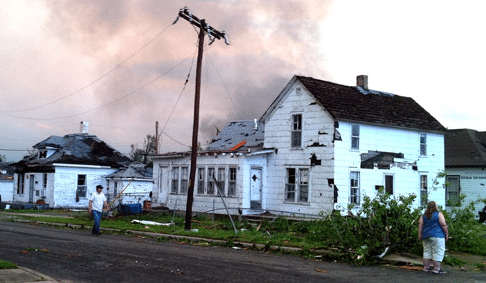by California Casualty | News |
 Twas the night before Christmas, when all through the land,
Twas the night before Christmas, when all through the land,
Not a member ignored, when they needed a hand,
Service reps on their phones, showing how much we care,
Whenever you need us, CalCas is there.
The educators celebrated, in their made-over lounge,
For ice and supplies, they’d no longer scrounge,
Firefighters entered some great giveaways,
Riding new Seadoos into hot summer days.
Nurses kept watch over the tired and sick,
But had comfy clogs, from jolly St. Nick.
Law Enforcement patrolled, keeping us secure,
While dreaming of Spring, and a long Harley tour.
When in the home office, there arose such a clatter,
Everyone was so proud to do things that matter,
With grants and awards, and a few giveaways,
Every morning here felt like a new Christmas Day.
Then, what to our wondering eyes should appear,
But our company’s leaders with a vision that’s clear,
Care for our customers, and follow the Code,
They called departments by name, and onward we rode,
On Sales and on Service, on Marketing and Claims,
On Field Marketing Managers (they know you by name),
Fill all their stockings with savings and surety,
And 100 more years of CalCas security!
by California Casualty | News |
 Ever wondered what it’s like to work for an insurance company that really cares about its customers? Want to be part of a team that supports the people that make our communities better – police, firefighters, nurses, and educators? Would you like to do it all from a beautiful office in Colorado Springs? Just read on to learn how!
Ever wondered what it’s like to work for an insurance company that really cares about its customers? Want to be part of a team that supports the people that make our communities better – police, firefighters, nurses, and educators? Would you like to do it all from a beautiful office in Colorado Springs? Just read on to learn how!
When:
Wednesday, October 26th from Noon-8pm
Where:
California Casualty
1650 Telstar Drive
Colorado Springs, CO 80920
*Please bring your resume to the event and be prepared for an on-site interview.
We’re hiring for the following positions at our Colorado Springs Service Center:
– Inbound Sales Representative
– Sales Consultant
Unable to attend? Search for jobs online or email us at [email protected]
by California Casualty | News |
Ingredients
 – 4 cups diced watermelon
– 4 cups diced watermelon
– 1 seeded and sliced cucumber
– handful of thinly sliced mint
– 1/2 cup thinly sliced jicima
– 1/4 cup olive oil
– juice of 1/2 of a lemon
– salt to taste
– crumbled goat cheese
– 1/4 cup chopped cashews – optional
Directions
Pat dry 4 cups diced watermelon and 1 seeded and sliced cucumber; toss with a handful of thinly sliced mint and jicima. Optional: add chopped cashews to the salad. Add 1/4 cup olive oil and the juice of 1/2 lemon; season with salt and toss. Top with crumbled goat cheese.
by California Casualty | News |
It’s been two weeks since an F5 Tornado decimated a large portion of Joplin, MO – killing at least 142 people and causing widespread devastation. Much of the city still lies in ruin, but an army of volunteers is working side-by-side with area firefighters and police to help locate missing people and to begin the clean up and recovery efforts.
Out of this disaster stems a number of stories – some of which are inspiring, and some are heart wrenching.

Riverside Police Department
First – Riverside, MO Police Officer Jeff Taylor was quick to volunteer his assistance in the city – a 3 hour drive from his home. While helping, lightning struck the ground near him on May 23rd. Officials in Riverside announced today that he died from the injuries sustained in the lightning strike – making the ultimate sacrifice while helping others. Jeff was 31 years old.(read more)
Next – Dr. Kevin Kitka, an ER doctor at St. John’s Regional provided a dramatic and poignant account of that day – as his hospital was ripped apart by the twister and they struggled to care for patients and a large number of new critically injured patients. It’s a harrowing tale, and I encourage you to read it in its entirety, to try to paraphrase it here doesn’t do it justice. (read it here)

The crushed SUV
Lastly – one of the many heartwarming stories of everyday people doing what they can to help out. A personal friend of mine, Marty Fahncke took it upon himself to assist in the cleanup effort. The hero in his story though, is his 6-year old son – who happened to be in the right place at the right time to help retrieve an elderly woman’s medication from a crushed SUV. When they pried open the door, he was the only person who could fit – and he braved broken glass and sharp metal to help a woman he had just met. Read the entire story here.
by California Casualty | News |
 On of my favorite summer foods is grilled zucchini and squash. It’s a great compliment to almost any meat, and it’s healthy and affordable. Try this delicious version and let me know what you think!
On of my favorite summer foods is grilled zucchini and squash. It’s a great compliment to almost any meat, and it’s healthy and affordable. Try this delicious version and let me know what you think!
Ingredients
- 3 zucchini
- 3 tablespoons butter, softened
- 2 cloves garlic, minced
- 1 tablespoon chopped fresh parsley
- 1/2 cup freshly grated Parmesan cheese
Directions
- Preheat an outdoor grill for medium-high heat, and lightly oil the grate.
- Cut the zucchini in half crosswise, then slice each half into 3 slices lengthwise, making 6 slices per zucchini.
- Mix the butter, garlic, and parsley in a bowl, and spread the mixture on both sides of each zucchini slice. Sprinkle one side of each slice with Parmesan cheese, and place the slices, cheese sides up, crosswise on the preheated grill to keep them from falling through.
- Grill the zucchini until the cheese has melted and the slices are cooked through and show grill marks, about 8 minutes.
by California Casualty | News |
Last evening, a massive tornado struck Joplin, MO – leaving at least 89 dead and many residents homeless. Between 25-30% of the city suffered significant damage, including a local hospital and school.
 Officials are urging residents to stay at home if possible, and extensive search and rescue efforts are underway. Joplin officials ask that any first responders or medical professionals who are available join in their efforts.
Officials are urging residents to stay at home if possible, and extensive search and rescue efforts are underway. Joplin officials ask that any first responders or medical professionals who are available join in their efforts.
Here is the info we’ve gathered so far – feel free to add in the comments or on our Facebook Page. We found quite a bit of this info here.
Joplin, MO Facebook Page for up to the minute conversations.
CNN Live Blog of the disaster
Red Cross Safe and Well page: Check to see if friends and family are safe and well. If you are a Joplin resident you can list yourself as safe and well on this site.
National Americorp Volunteers are setting up a national hotline for residents to call to check on loved ones. The number is (417) 659-5464 .
Online map with specific site related information for Joplin, MO tornado.
Other numbers to call — triage centers:
417-623-3254 (joplin memorial hall)
417-624-9320 (mcauley school)
417-347-6656 (freeman hospital)
Integris Baptist Health Center in Miami – 918-542-6611
McCune Brooks Hospital in Carthage 417-358-8121
St. John’s Hospital in Springfield 417-820-2000
Via Christi in Pittsburg 620-231-6100
Barton County hospital in Lamar 417-681-5700
 Twas the night before Christmas, when all through the land,
Twas the night before Christmas, when all through the land,
 – 4 cups diced watermelon
– 4 cups diced watermelon

 On of my favorite summer foods is grilled zucchini and squash. It’s a great compliment to almost any meat, and it’s healthy and affordable. Try this delicious version and let me know what you think!
On of my favorite summer foods is grilled zucchini and squash. It’s a great compliment to almost any meat, and it’s healthy and affordable. Try this delicious version and let me know what you think! Officials are urging residents to stay at home if possible, and extensive search and rescue efforts are underway. Joplin officials ask that any first responders or medical professionals who are available join in their efforts.
Officials are urging residents to stay at home if possible, and extensive search and rescue efforts are underway. Joplin officials ask that any first responders or medical professionals who are available join in their efforts.